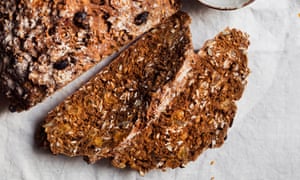https://www.theguardian.com/lifeandstyle/2017/jan/01/nigel-slater-new-years-day-knead-free-knobbly-loaf
Nigel Slater’s New Year’s Day knead-free knobbly loaf

Ibegin the year with flour on my hands. Something of a ritual. The kneading of dough is the way I have started the new year for as long as I can remember. This time though, a change of step. A dough that requires mixing, cake-like, in a capacious bowl, rather than pummelling on a board. One that requires little kneading – only one proving, and keeps like an old friend.
This is a sticky dough, too wet to push and stretch with your hand. The texture is akin to Christmas cake and almost as generously stippled with fruit and seeds. The bread itself is sweet with sultanas, has the soft crunch of pumpkin and sunflower seeds and is as dark as a ginger cake.
A dose of black treacle ensures the loaf is a keeper: four or five days if wrapped tightly. The pebbledash of seeds ensures not only an interesting texture to each cut slice, but a sprinkling of fibre and a handful of the sort of good things you find listed on the side of a cornflakes packet. The golden linseed, especially when lightly crushed, brings with it the gift of omega-3 fats.
Once the fruit-freckled dough has risen to almost twice its size, I lift it carefully from its bowl, trying not to disturb its dumpy, dome-like shape, place it straight down on to a hot baking stone and then into the hot oven. Its shape returns like a plumped-up cushion. Use a loaf tin if you like your toast neat.
As much as I enjoy trickling olive oil over black-crusted sourdough, for densely textured, slightly sweeter breads such as this, it has to be butter. A pale, unsullied butter is ointment enough, but this time I go to town seasoning a pack of sweet, almost white, unsalted butter with onions cooked to a deep bronze, snipped dill, juniper and crystalline flakes of smoked sea salt. It’s a butter that stands up well with a breakfast kipper, melting sweetly over the mahogany surface of the smoked flesh, and is just the job to fork into the fluffy heart of a baked potato on a frosty night.
Linseed and treacle bread
I heartily recommend putting a baking stone in the oven to heat up first. Makes a medium-sized loaf.
rye flour 200g
strong white bread flour 200g
barley flakes 50g
sea salt 1 tsp
black treacle 2 tbsp, lightly heaped
warm water 350ml
fast-acting yeast 1 x 7g sachet
rolled oats 40g
pumpkin seeds 35g
sunflower seeds 25g
golden linseeds 30g
golden sultanas 75g
strong white bread flour 200g
barley flakes 50g
sea salt 1 tsp
black treacle 2 tbsp, lightly heaped
warm water 350ml
fast-acting yeast 1 x 7g sachet
rolled oats 40g
pumpkin seeds 35g
sunflower seeds 25g
golden linseeds 30g
golden sultanas 75g
Warm a deep, wide mixing bowl. The warmth will help your dough rise more quickly. Combine the flours and barley flakes then lightly crush the sea salt flakes in the palm of your hand and stir them in.
Put the black treacle into a jug then stir in the warm water, dissolving the treacle as you stir. Tip in the yeast, let it dissolve then pour into the flour and barley. Using a wooden spoon rather than your hands – the dough is sticky – stir in the rolled oats, pumpkin, sunflower, golden linseeds and sultanas. Mix for a full minute, so the flour, liquid, seeds and fruits are thoroughly combined. The texture of the dough should be very moist, poised between that of a bread dough and a cake mixture.
Dust the surface lightly with flour, cover with a tea towel and leave in a warm place for an hour or so. Any warm, draught-free spot will work. Check the bowl occasionally to make sure it is warm, but not too hot.
Get the oven hot – it will need to be at 220C/gas mark 8. If you have one, place a bread or pizza stone, generously floured, in the oven to get hot. Failing that, a baking sheet will do. When the oven is up to temperature and the dough has risen to almost twice its original volume, transfer it to the hot baking stone or sheet, reshaping it into a round loaf as you go. Bake for 35 minutes, until the crust is lightly crisp and the base sounds hollow when tapped.
Transfer the warm loaf to a cooling rack and allow to rest for a good 30 minutes before slicing. The loaf will keep, wrapped in clingfilm and foil, for 4 or 5 days.

No comments:
Post a Comment